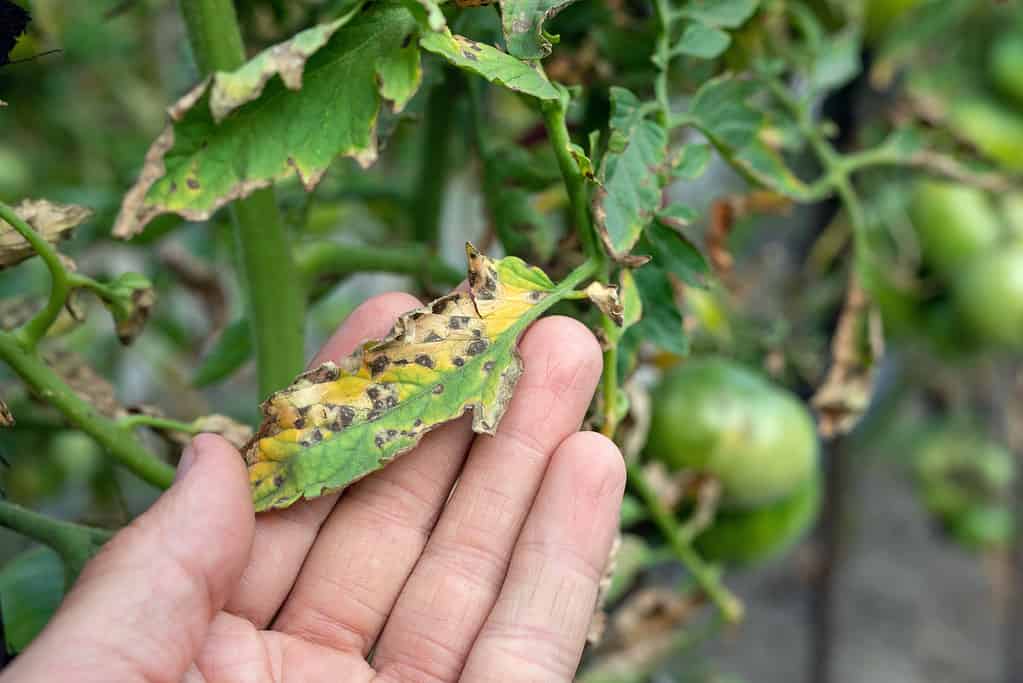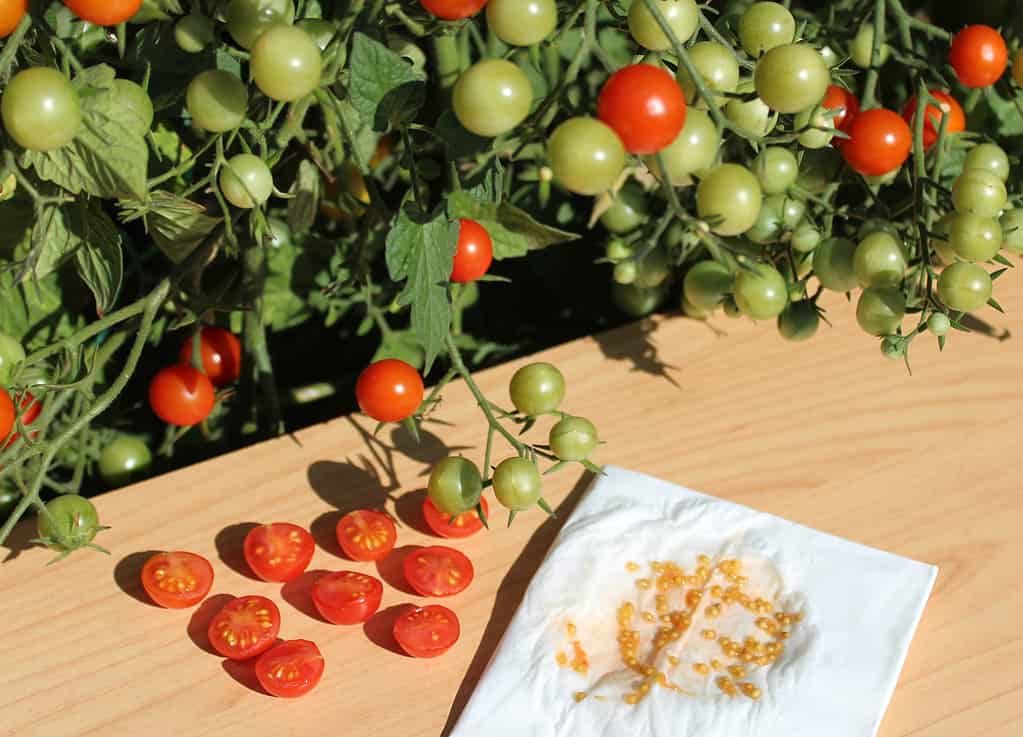There’s nothing more demoralizing than watching your lush tomato plants wither as the weather gets colder. This leaves a lot of gardeners wondering: can tomato plants survive winter with proper care?
In this article, we’ll cover whether tomatoes can survive the winter, steps to keep them alive, and whether your efforts will be worth it.
Let’s dig in!
Can Tomatoes Survive the Winter?
Tomatoes can survive the winter with proper care. They’ll enter a dormant period, similar to other plants, then produce again in the spring.
However, dormant tomato plants are incredibly high maintenance and require a lot of attention. Even with all of that work, they may not produce a great yield the following spring. Many modern varieties are cultivated as annuals and don’t have the life and longevity of heirloom or wild tomatoes.
With that in mind, here are some essential tips to keep them alive.
How to Overwinter Tomatoes

Tomatoes need at least eight hours of sunlight each day.
©IrinaPhVideo/Shutterstock.com
There are two approaches to overwintering tomatoes: keeping them outdoors or moving them indoors. There are several factors that will determine the best type of approach to help your tomato plants survive the winter.
Consider Your USDA Zone
Tomatoes are generally not cold hardy and easily succumb to frost. If you live in USDA zones 9b and above, you can keep your tomato plants outdoors with simple protective measures.
Conversely, if you live in USDA zone 9a or lower, you’re unlikely to successfully keep your tomato plants alive outdoors. Transplanting them indoors is the best option for you.
Choosing the Right Type of Tomatoes

Vining tomato plants tend to perform better than bushy tomato plants.
©aRandomEye/Shutterstock.com
Some tomatoes do better in the cold than others. There are two overarching categories of tomatoes: determinate and indeterminate.
Most varieties sold at farmers’ markets and in seed packs are determinate. They have bushy growth, a set growing season, and grow to consistent heights and yields.
Indeterminate tomatoes are wilder, with vining growth, an extended ripening period, and unclear limits on growth potential.
Indeterminate tomatoes tend to perform better when overwintered, either indoors or outdoors. Heirloom and cherry varieties are best for this experiment.
Light Requirements
Tomatoes require a lot of sunlight to thrive—at least eight hours daily! It’s unlikely that your tomato plants will get sufficient lighting indoors. Fortunately, you can use an LED grow light to support them all winter.
If you live in a warmer climate that experiences extended periods of rain or overcast weather during the winter, consider moving your tomatoes indoors instead and using a grow light.
Watering Requirements

Tomatoes thrive with consistent moisture.
©iStock.com/Wirestock
Your tomato plants require consistent moisture to thrive. However, you can reduce watering frequency if they’re entering a dormant period. It ultimately depends on whether you’re opting for a continuous harvest or trying to bring your plant back in the spring.
Tomato Winter Placement
Place indoor tomato plants away from drafts and vents. Place them near a sunny window with a consistent temperature and humidity.
Frost Protection
Frost protection is crucial for helping your tomato plants survive winter. Start by adding a layer of mulch around the roots, then cover with a clear, insulating layer. For example, you can use plastic tarping or repurposed 18-liter water jugs. These provide a layer of protection while letting the sun shine through.
Add a thermal layer over the plants for particularly cold nights, removing it in the morning to let the sun in. Some crafty gardeners also use their old-school Christmas lights (not LED bulbs) to provide extra warmth!
Pruning and Pest Removal

Remove damaged and diseased tomato plants.
©Andrey Maximenko/iStock via Getty Images
As the weather starts to cool down, start tending to your plants. Prune away dead tissue and remove or treat any pest infestations. Take the time to dig up dead or rotten plants to prevent the spread of infection to your healthy plants.
Transitioning Plants Indoors
Established tomato plants don’t transplant well. However, if you’re set on trying, carefully dig up your plant, wipe excess dirt away from the roots, and transfer it into a pot with fresh soil and plenty of drainage.
Water your plant a few days before transplanting to improve its chances of survival. Then, leave the plant outdoors in the pot to let it adjust for a few days. Plan this exercise a few weeks before the first frost!
Pollinate Your Plants
Tomatoes are self-pollinators but usually get some help from butterflies and bees. Your tomato plant may need assistance as these helping hands won’t be around during the winter or indoors.
Turn a gentle fan on your tomato plants to help loosen pollen and ensure it gets from the anther to the stigma. Conversely, you can use a soft paintbrush to spread the pollen manually.
Alternatives to Overwintering Tomatoes

Seed harvesting is a smart alternative to moving tomatoes indoors for the winter.
©Martina Unbehauen/Shutterstock.com
The effort of moving tomato plants indoors or tending to established plants all winter likely isn’t worth it. However, there are other ways to ensure the continuity of your favorite plants.
Seed Harvesting
Seed harvesting is the process of removing seeds from your crop, processing them, storing them, and planting them the following spring. This helps cut the cost of gardening and helps homesteaders create a continuous stash of seeds.
Propagating Tomato Plants
Another preferred alternative to keeping tomatoes alive for the winter is to propagate your plants before the first frost and start new plants from the cuttings.
Take a cutting from an established branch and place it in a glass of water for a couple of weeks. Once roots develop, you can move the tomato plant to the soil and care for it indoors over the winter for a continuous harvest.
Growing New Tomatoes Indoors
Another option is to save some seeds (or use seeds you harvest) to grow entirely new tomato plants indoors all winter. You will need LED grow lights for this approach. Consider staggering your planting schedule for an extended harvest.
The photo featured at the top of this post is © SRGongal/Shutterstock.com
Thank you for reading! Have some feedback for us? Contact the AZ Animals editorial team.







